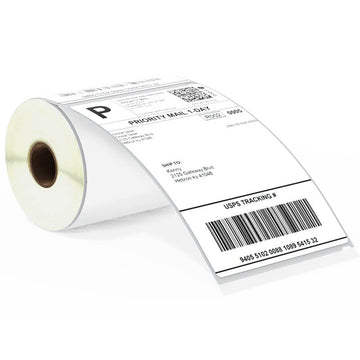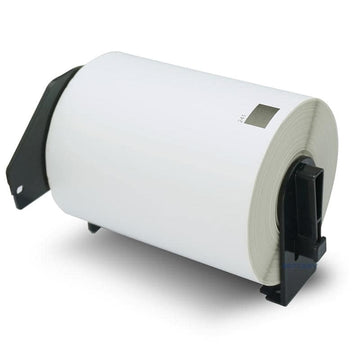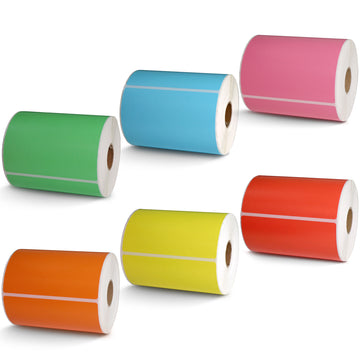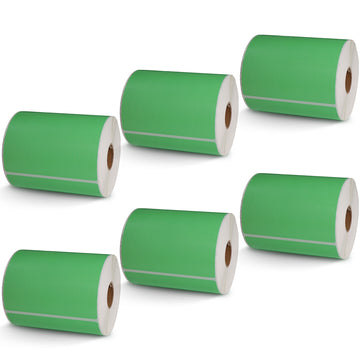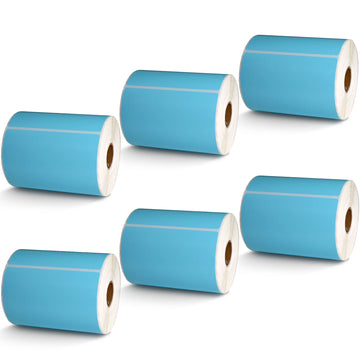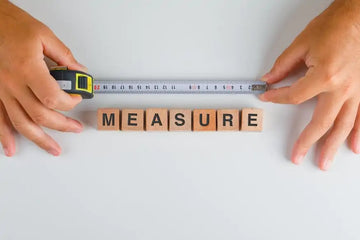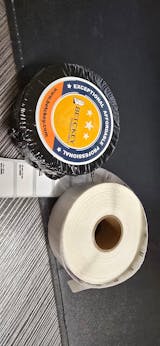Table of Contents
- 1.Labels and Label Printers
- 2.Types of Labels According to Their Printing Technology
- 3.Key Factors to Measure
- 4.How to Measure a Label Roll Size?
- 5.Measuring Tips
- 6.Example Label Rolls
- 7.To Wrap Up
Labels and label printers are essential for organizational efficiency, compliance, marketing, and operational effectiveness. They ensure compliance with regulations, enhance brand visibility, and reduce errors. Automated printing saves time and costs, while providing consistent and clear product information.
However, there are still many people, from individuals to business owners don’t know clearly how to choose proper sized labels according to large amount of questions given to our online shop post-sales personnel, so we are here to provide basic knowledge of labels and help you quickly know how to measure labels rolls. Let’s get started!
Labels and Label Printers

When selecting labels, it's important to match the label material and size to the intended application to ensure optimal performance. For example, labels for outdoor use may need to be made from more durable materials like weather-resistant plastics or laminated films, whereas indoor labels might be adequately served by standard paper labels. Additionally, the choice of adhesive strength can vary depending on whether the label needs to be permanent, removable, or repositionable. Budget constraints can also influence the decision, as higher-quality materials and advanced printing technologies may come at a higher cost. Ultimately, understanding the specific requirements of your labeling task and the capabilities of your label printer will help you make the best choice for your needs.
Additionally, it is important to consider the specific features and capabilities of a label printer based on your labeling needs. Features such as adjustable print speeds, label widths, connectivity options (like USB or Wi-Fi), and compatibility with different types of labels can all impact the efficiency and effectiveness of your label production. Investing in a printer that meets your current requirements while offering some flexibility for future needs can be a smart strategy. Furthermore, regular maintenance and proper handling of both the label printer and the labels can help extend the lifespan of the equipment and ensure consistent print quality over time. By carefully evaluating these factors, you can select a label printer that best fits your business or personal labeling tasks.
Types of Labels According to Their Printing Technology

Common types of label rolls according to their printing technology include:
- Direct thermal labels
- Thermal transfer labels
- Laser labels
- Tags
- RFID labels
- Freezer labels
In particular, Direct Thermal Labels and Thermal Transfer Labels are the two most important types to know about, given that they are the most commonly applied technologies for various labeling applications.

|
|
Direct Thermal Printing |
Thermal Transfer Printing |
|
The Need for Ribbons |
No |
Yes |
|
Consumables |
Special thermal paper with a heat-sensitive coating that changes color when heated |
Various label media such as adhesive label paper, PET, PVC, wash care labels, hang tags, and also thermal paper |
|
Cost |
Relatively low |
Relatively high |
|
Label Longevity |
Typically last about six months, influenced by light and temperature conditions. The good news is that Betchey has come up with labels that last for up to 2 years, so you no longer need to worry about this. |
Generally lasts over two years, depending on the quality of the label paper and ribbon |
|
Suitable Scenarios |
Retail industries like supermarkets, apparel, and logistics where barcode requirements are not stringent |
Industries requiring high-quality and durable labels, such as manufacturing, automotive, and food industries |
|
Recommendation |
Suitable for scenarios needing short-term label preservation and cost considerations |
Ideal for environments where labels need to be preserved for long periods and remain legible under various conditions |
How to Measure a Label Roll Size?

Key Factors to Measure
To measure a label roll size, consider the following factors:

- Paper Tube Diameter(Core Diameter): The inner diameter of the label roll. The inner diameter of the core is typically 3 inches (76 mm) for commercial and industrial barcode printers. For desktop barcode printers, the core’s inner diameter is usually 1 inches (38 mm). However, there are no strict limitations on the core's inner diameter specification, as long as it can be installed on the label holder.
- Outer Diameter:The outer diameter of the label roll.
- Full Roll Width:The total width of the label, accounting for the spaces on either side.
- Label Width:The width of each individual label.
- Label Length:The length of each individual label.
- Number of Labels:The total number of labels on the roll.
Measuring Tips
- Check Specifications:Always refer to the manufacturer's specifications for accurate measurements.
- Use Proper Tools:For precise measurements, use a caliper or a ruler with fine markings.
Example Label Rolls
Dymo 30252 Compatible Address Labels
- Label width: 1 1/8(1.25)inches
- Label length: 3 1/2(3.5) inches
- Paper tube diameter: 1 inch
- Outer diameter: 4 inches
- Number of labels: 350 labels
Zebra Barcode Direct Thermal Labels
- Label width: 1.25 inches
- Label length: 2.25 inches
- Paper tube diameter: 1 inch
- Outer diameter: 8 inches
- Number of labels: 1000 labels
To Wrap Up
Now that you understand the basics of label printers, materials, and measurements, you’re ready for your labeling projects! Choose high-quality label rolls for the best results, and consider Betchey label rolls for high value for money products and excellent service. Contact us with your label roll details for a personalized quote!









